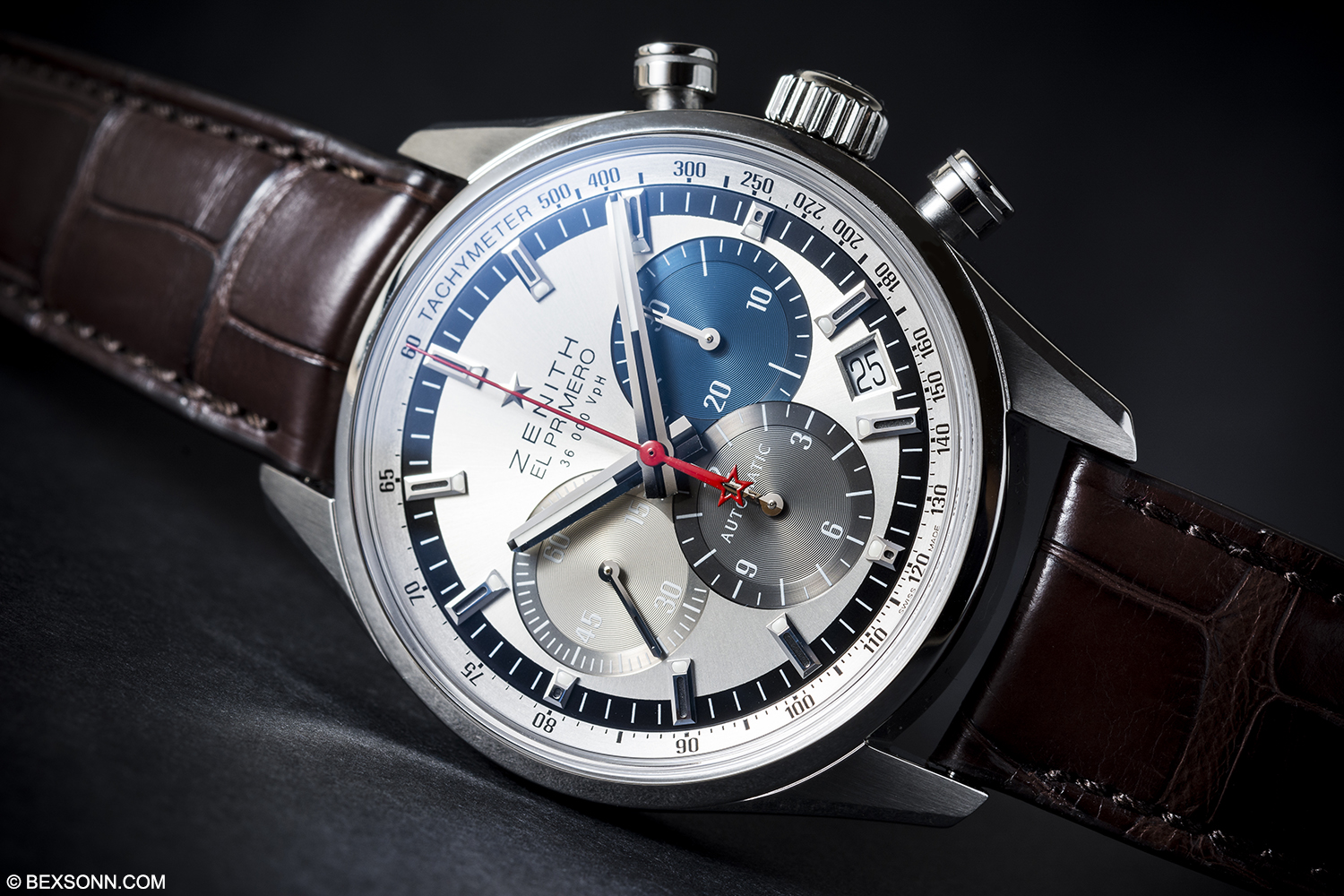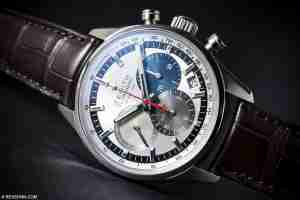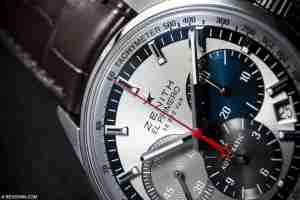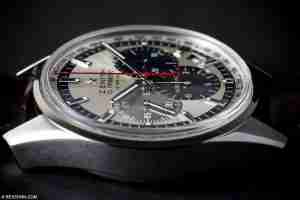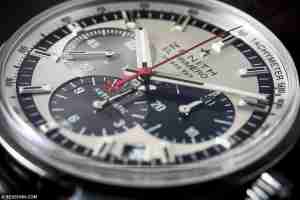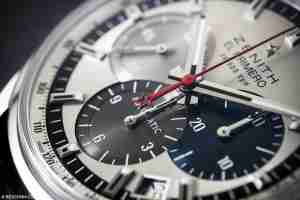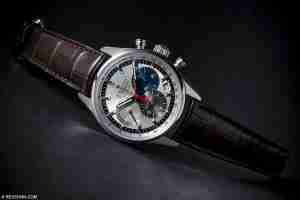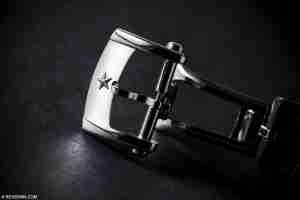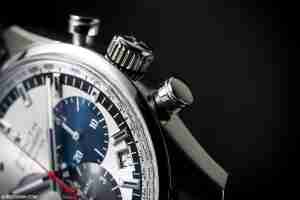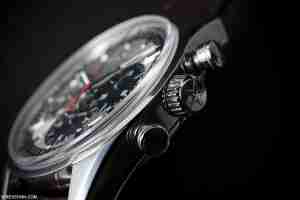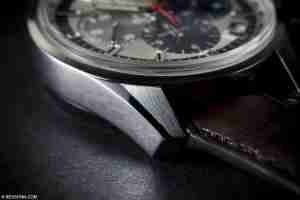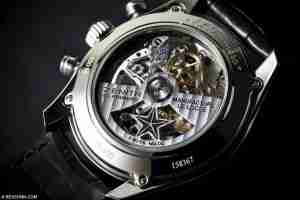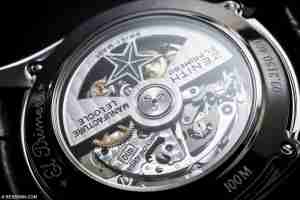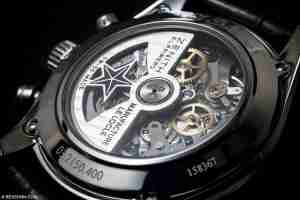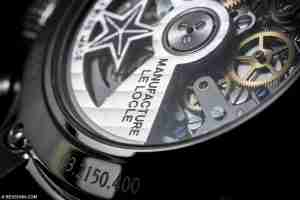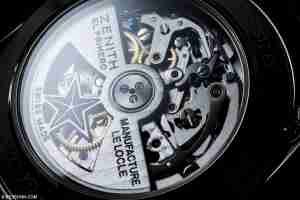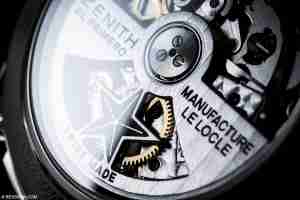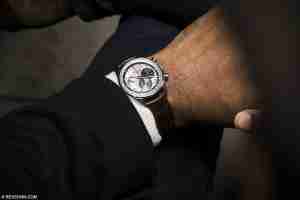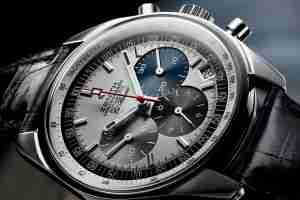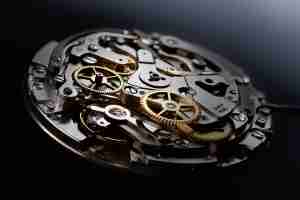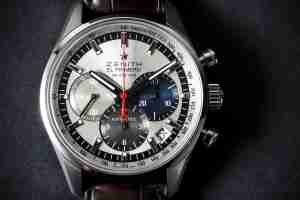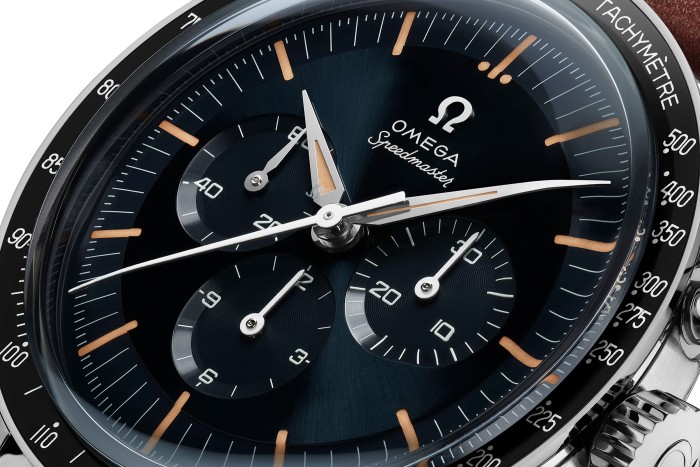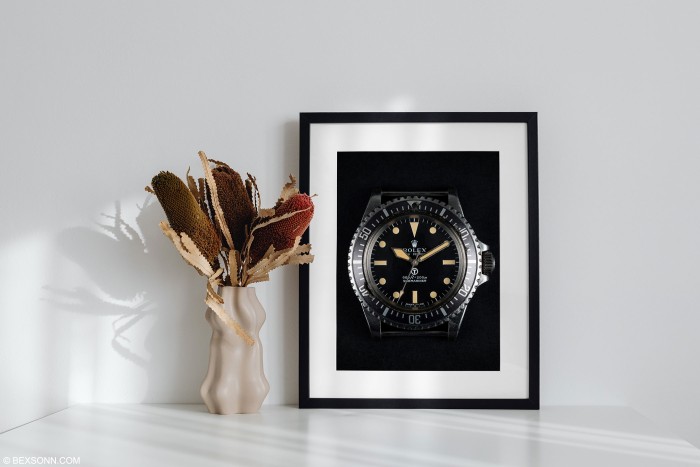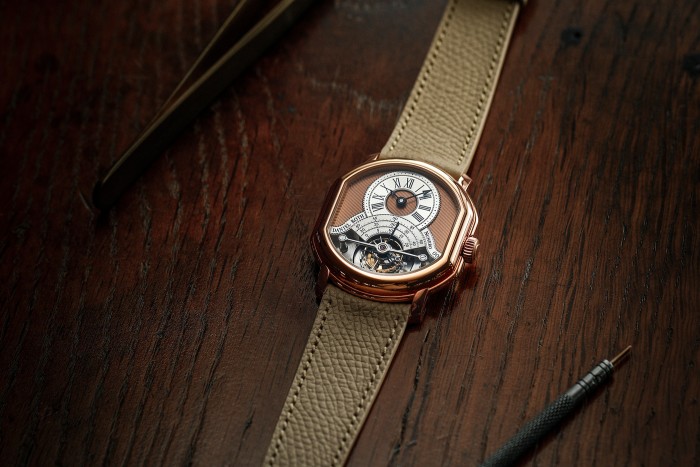Zenith El Primero Original 1969: What is there to say about the El Primero? Quite a lot really. You see, we’re talking about one of the most important manufactures in history that produced, arguably, one of the most important watch movements of the 20th century. As we all know, chronographs have been around since the 19th century but it wasn’t that long ago that automatic chronographs were introduced. It was only as recently as the 1960s that there was a push to invent an automatic chronograph and while Zenith can be considered the first, it wasn’t quite that straight forward.
EL PRIMERO (THE FIRST)
The El Primero is a legend within its own right but there is a much debated story behind it. During the early 1960s there was a race on to see who could create the world’s first self-winding (automatic) chronograph. There were of course a few companies that shared an interest in claiming this technological breakthrough: Heuer/Buren-Hamilton/Breitling. However, there were a couple of silent watch manufactures working on this advance too: in the Far East was Seiko, who were busy working on their own version and then there was company from Le Locle – Zenith!
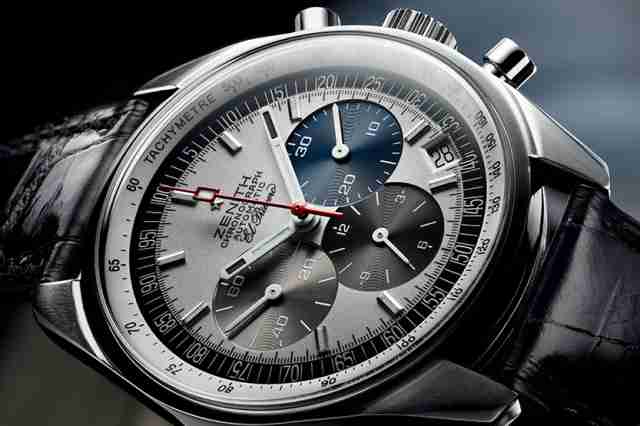 But, and it is a big but, who was first? Was it Heuer/Hamilton-Buren/Breitling or Seiko who actually beat Zenith to the market? This has long been analysed in detail and you can read that in-depth story on Project 99 written by none other than Jeff Stein. But when it all comes down to it, the fact of the matter is this. While Heuer were better prepared for production and Seiko silently released theirs in 1969 (but was only made available to the Japanese market) – it was Zenith who actually announced their automatic chronograph movement first. It was that 7 year journey that started in 1962 that produced, arguably, one of the best automatic chronographs ever made. Though you can’t take anything away from Heuer and Seiko, Zenith produced the more superior automatic chronograph movement in the El Primero.
But, and it is a big but, who was first? Was it Heuer/Hamilton-Buren/Breitling or Seiko who actually beat Zenith to the market? This has long been analysed in detail and you can read that in-depth story on Project 99 written by none other than Jeff Stein. But when it all comes down to it, the fact of the matter is this. While Heuer were better prepared for production and Seiko silently released theirs in 1969 (but was only made available to the Japanese market) – it was Zenith who actually announced their automatic chronograph movement first. It was that 7 year journey that started in 1962 that produced, arguably, one of the best automatic chronographs ever made. Though you can’t take anything away from Heuer and Seiko, Zenith produced the more superior automatic chronograph movement in the El Primero.
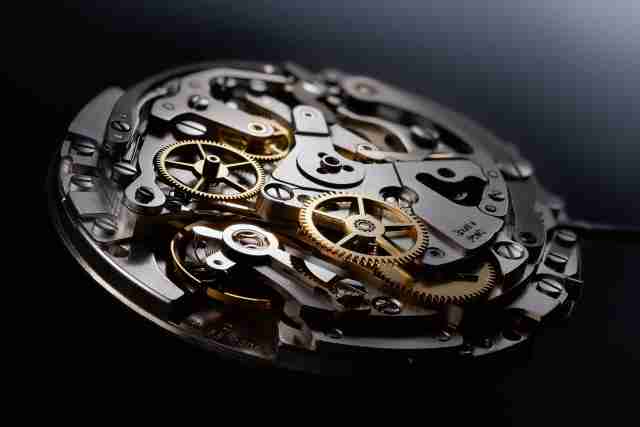 Of course the dispute will go and the likes of Heuer and Seiko played their part in history but 46 years later the El Primero movement is still being utilised today and it has more or less remained unchanged. Even when the El Primero was consigned to the shelves during the quartz crisis, it wasn’t forgotten and the likes of Rolex would go on to use the El Primero movement in the Daytona and Zenith themselves would go on to use this movement in a number of other timepieces within their range.
Of course the dispute will go and the likes of Heuer and Seiko played their part in history but 46 years later the El Primero movement is still being utilised today and it has more or less remained unchanged. Even when the El Primero was consigned to the shelves during the quartz crisis, it wasn’t forgotten and the likes of Rolex would go on to use the El Primero movement in the Daytona and Zenith themselves would go on to use this movement in a number of other timepieces within their range.
EL PRIMERO ORIGINAL 1969
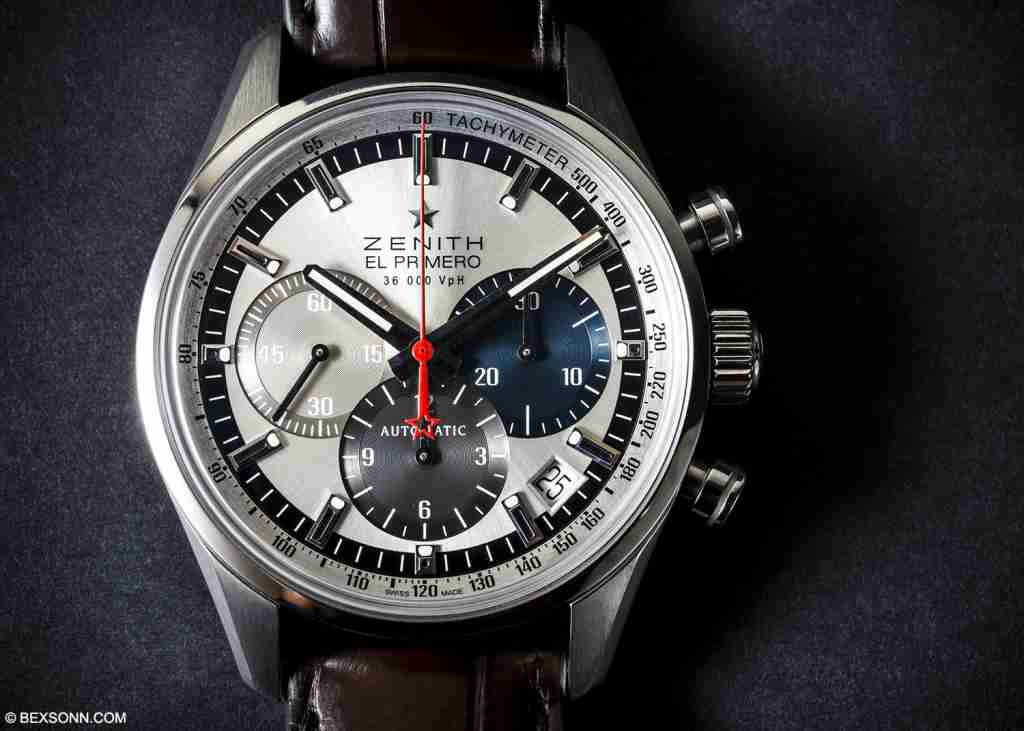 In 2009 Zenith introduced the El Primero 1969, which of course takes its design cues from the vintage model that first graced the automatic chronograph scenes way back in 1969: the A386. While other events were also taking place in this same year, such as the moon landing, Zenith were making another kind of leap. But while Zenith have introduced many El Primero models throughout the years, in my opinion, this 1969 is just about as good as it gets, albeit if you can get your hands on an original A386. It was no accident that this model was introduced in the 2009, it was of course made to celebrate the 40th anniversary of the El Primero and I think one could even say it was a tribute well done.
In 2009 Zenith introduced the El Primero 1969, which of course takes its design cues from the vintage model that first graced the automatic chronograph scenes way back in 1969: the A386. While other events were also taking place in this same year, such as the moon landing, Zenith were making another kind of leap. But while Zenith have introduced many El Primero models throughout the years, in my opinion, this 1969 is just about as good as it gets, albeit if you can get your hands on an original A386. It was no accident that this model was introduced in the 2009, it was of course made to celebrate the 40th anniversary of the El Primero and I think one could even say it was a tribute well done.
THE MOVEMENT
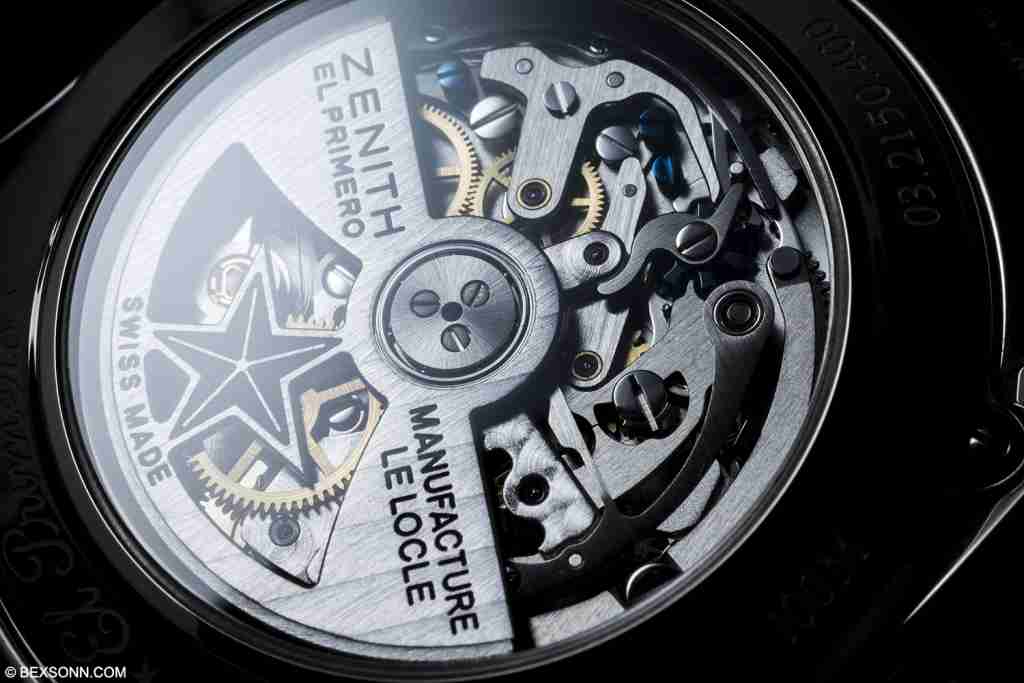 I’m going to start at the movement here because this is one of the most important aspects of the El Primero. As we’ve already mentioned Zenith won the race in announcing their self-winding chronograph movement first but even more interesting than that, it has seen very little in the way of modifications since then. Even when Rolex were tasked to find a self-winding chronograph movement that was slim enough to fit into the Daytona, the El Primero was the movement of choice; they even pared down its ridiculous beat rate to 28,000 vph from 36,000 vph. However, this high-beat rate has its advantages. Beating at 36,000 vph (inscribed on the dial below the wording El Primero) allows the chronograph to provide a more accurate reading and also provides a smoother chronograph and running seconds sweeping hand.
I’m going to start at the movement here because this is one of the most important aspects of the El Primero. As we’ve already mentioned Zenith won the race in announcing their self-winding chronograph movement first but even more interesting than that, it has seen very little in the way of modifications since then. Even when Rolex were tasked to find a self-winding chronograph movement that was slim enough to fit into the Daytona, the El Primero was the movement of choice; they even pared down its ridiculous beat rate to 28,000 vph from 36,000 vph. However, this high-beat rate has its advantages. Beating at 36,000 vph (inscribed on the dial below the wording El Primero) allows the chronograph to provide a more accurate reading and also provides a smoother chronograph and running seconds sweeping hand.
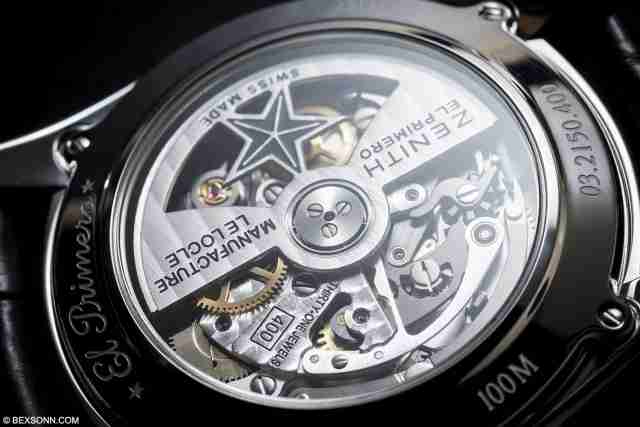 Inside the 1969 is the El Primero calibre 400 automatic, which has been beautifully finished and sports a rather industrious look, even though the oscillating weight bears the undulating “Côtes de Genève”. Looking beyond the weight, you’ll be able to see the standout golden gears, blued screws and just some of the 31 jewels and 278 components that makeup the calibre 400. Much of the cases slight profile is down to the movement, which measures a mere 30mm x 6.6mm. While this may not sound that slim, bear in mind this is an automatic chronograph that utilises a column wheel mechanism.
Inside the 1969 is the El Primero calibre 400 automatic, which has been beautifully finished and sports a rather industrious look, even though the oscillating weight bears the undulating “Côtes de Genève”. Looking beyond the weight, you’ll be able to see the standout golden gears, blued screws and just some of the 31 jewels and 278 components that makeup the calibre 400. Much of the cases slight profile is down to the movement, which measures a mere 30mm x 6.6mm. While this may not sound that slim, bear in mind this is an automatic chronograph that utilises a column wheel mechanism.
THE DIAL
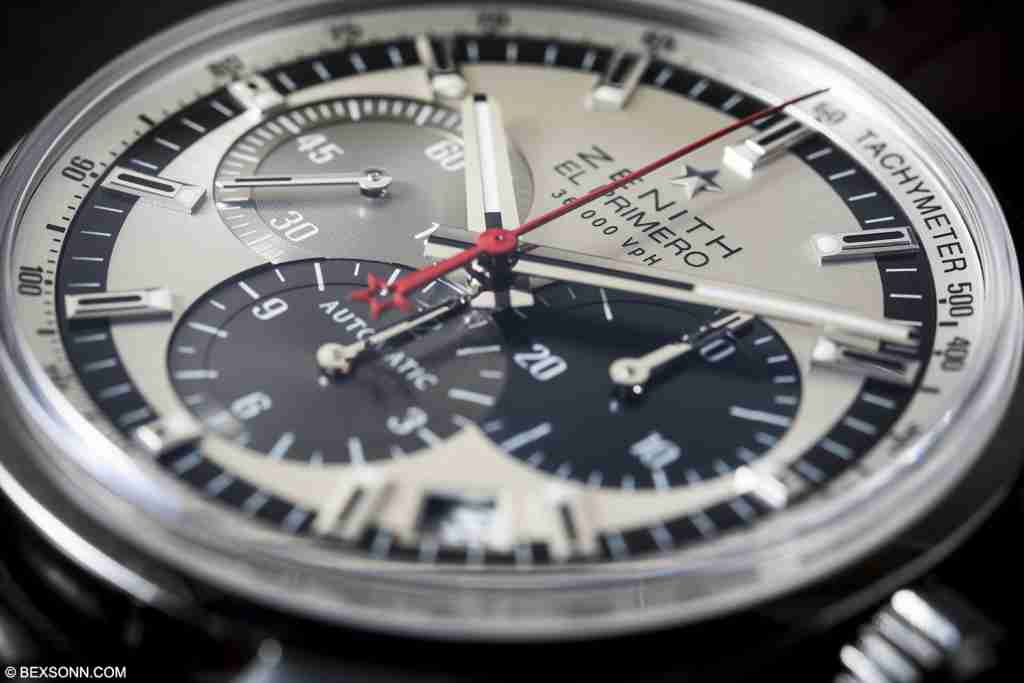 At first glance, you’d be forgiven for thinking this was the original El Primero. Zentih have tried to stay as close as possible to the original design and admittedly they’ve done a very good job. But upon closer inspection you’ll notice that pretty much every detail is different but this isn’t a bad thing. It is only until you look at both of them side-by-side do you actually notice the differences. Of course the all new El Primero’ now makes use of the signature red chronograph seconds hand, which sports a hollowed star counterweight that has long been Zenith’s emblem but the original standout feature has remained: the overlapping tri-colour sub dials.
At first glance, you’d be forgiven for thinking this was the original El Primero. Zentih have tried to stay as close as possible to the original design and admittedly they’ve done a very good job. But upon closer inspection you’ll notice that pretty much every detail is different but this isn’t a bad thing. It is only until you look at both of them side-by-side do you actually notice the differences. Of course the all new El Primero’ now makes use of the signature red chronograph seconds hand, which sports a hollowed star counterweight that has long been Zenith’s emblem but the original standout feature has remained: the overlapping tri-colour sub dials.
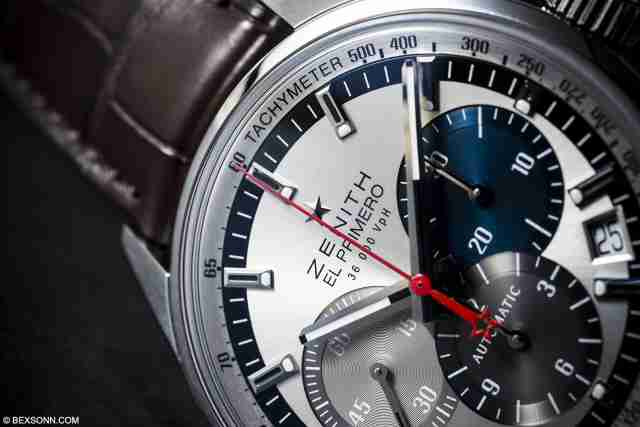 El Primero’ 3 overlapping subsidiary dials: light grey, blue and anthracite grey, are said to have been inspired by the skies. At 9 o’clock is the running seconds, with accumulated minutes at 3 and recorded hours down at 6 o’clock, which also bears the inscription ‘automatic’. The base of the dial is an eye-catching Sunray creamy/silvery tone, with a black chapter ring and white minute markers. The ingot-shaped faceted rhodium-plated hour markers feature one edge that is coated with SuperLuminova and are placed right on the cusp of the tachymeter scale flange, where the dial has a very slight incline. In between 4 and 5 o’clock is the date aperture, which is rather un-intrusive and doesn’t seem to unbalance the dial at all. Another change to that of its predecessor are the polished rhodium-plated hands that taper towards the end. Admittedly, it would’ve been nice to see something more akin to the white stick hands used on the original.
El Primero’ 3 overlapping subsidiary dials: light grey, blue and anthracite grey, are said to have been inspired by the skies. At 9 o’clock is the running seconds, with accumulated minutes at 3 and recorded hours down at 6 o’clock, which also bears the inscription ‘automatic’. The base of the dial is an eye-catching Sunray creamy/silvery tone, with a black chapter ring and white minute markers. The ingot-shaped faceted rhodium-plated hour markers feature one edge that is coated with SuperLuminova and are placed right on the cusp of the tachymeter scale flange, where the dial has a very slight incline. In between 4 and 5 o’clock is the date aperture, which is rather un-intrusive and doesn’t seem to unbalance the dial at all. Another change to that of its predecessor are the polished rhodium-plated hands that taper towards the end. Admittedly, it would’ve been nice to see something more akin to the white stick hands used on the original.
THE CASE & STRAP
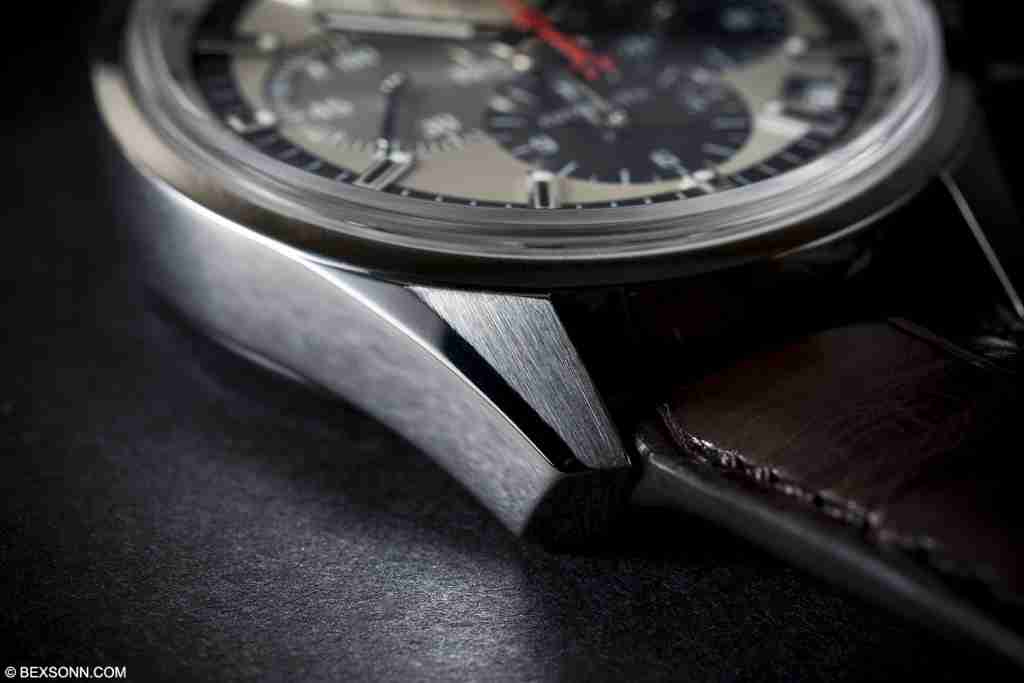 For me the case on the El Primero 1969 is an absolute winner. Measuring a very classical 38mm in diameter it strikes a nostalgic chord. Constructed from stainless steel the case, arguably, bears the closest resemblance to the original El Primero. The straight, symmetrical, brushed lugs sport a polished chamfered edge and a shallow indentation towards the bezel, which is in keeping with the original. The 12.45mm thick case, sports a polished band to match the very thin bezel, which holds the box-shaped, domed sapphire crystal that features anti-reflective treatment on both sides, in place.
For me the case on the El Primero 1969 is an absolute winner. Measuring a very classical 38mm in diameter it strikes a nostalgic chord. Constructed from stainless steel the case, arguably, bears the closest resemblance to the original El Primero. The straight, symmetrical, brushed lugs sport a polished chamfered edge and a shallow indentation towards the bezel, which is in keeping with the original. The 12.45mm thick case, sports a polished band to match the very thin bezel, which holds the box-shaped, domed sapphire crystal that features anti-reflective treatment on both sides, in place.
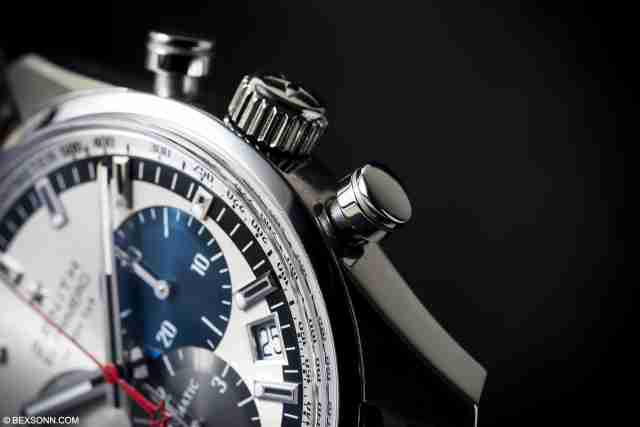 The pronounced pushers are also polished and quite wide, which actually lends to the comfort during actuation. The large fluted crown bears an embossed Zenith star logo and has an interesting setup. The first position is actually used to set the time and the second position is used to operate quickset-date function. Turning the case over you’ll see the sapphire display case back, which offers a glimpse of the El Primero 400.
The pronounced pushers are also polished and quite wide, which actually lends to the comfort during actuation. The large fluted crown bears an embossed Zenith star logo and has an interesting setup. The first position is actually used to set the time and the second position is used to operate quickset-date function. Turning the case over you’ll see the sapphire display case back, which offers a glimpse of the El Primero 400.
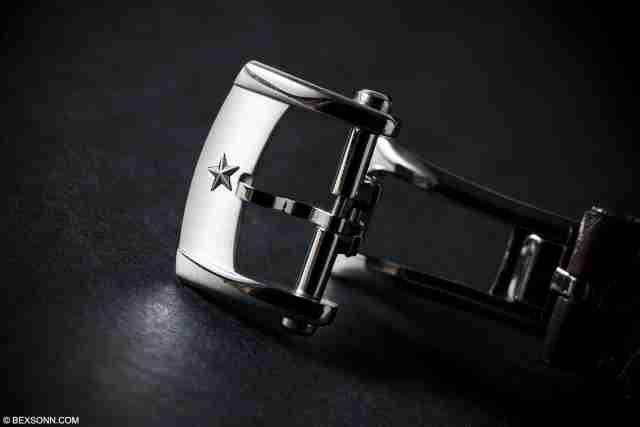 The Zenith El Primero I managed to get my hands on came on a brown Alligator leather strap, with rubber lining and a deployant clasp that admittedly was a little fiddly to begin with but once adjusted was a breeze to strap on. There is also a steel bracelet variation that features a brushed and polished finish, which would probably be my choice when selecting, as this offers more options when it comes to changing things up a bit. Though it does measure an unusual 19mm from lug-to-lug.
The Zenith El Primero I managed to get my hands on came on a brown Alligator leather strap, with rubber lining and a deployant clasp that admittedly was a little fiddly to begin with but once adjusted was a breeze to strap on. There is also a steel bracelet variation that features a brushed and polished finish, which would probably be my choice when selecting, as this offers more options when it comes to changing things up a bit. Though it does measure an unusual 19mm from lug-to-lug.
CONCLUSION
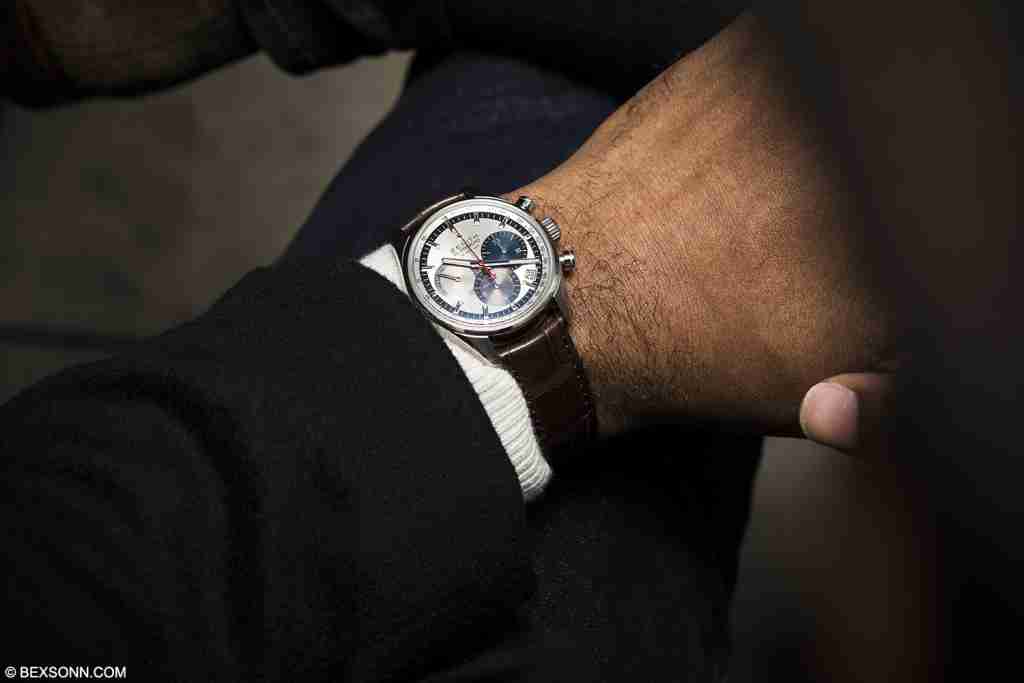 I have always been an admirer of the Zenith El Primero reference A386 and to know that it played such an important part in chronograph history is the icing on the cake. For the couple of weeks that I had the El Primero 1969 it was incredibly comfortable to wear and sat snuggly on the wrist. Even with my 7” wrists, at no point did the 38mm case look or feel too small, though it would’ve been great to see how the bracelet differs to the strap.
I have always been an admirer of the Zenith El Primero reference A386 and to know that it played such an important part in chronograph history is the icing on the cake. For the couple of weeks that I had the El Primero 1969 it was incredibly comfortable to wear and sat snuggly on the wrist. Even with my 7” wrists, at no point did the 38mm case look or feel too small, though it would’ve been great to see how the bracelet differs to the strap.
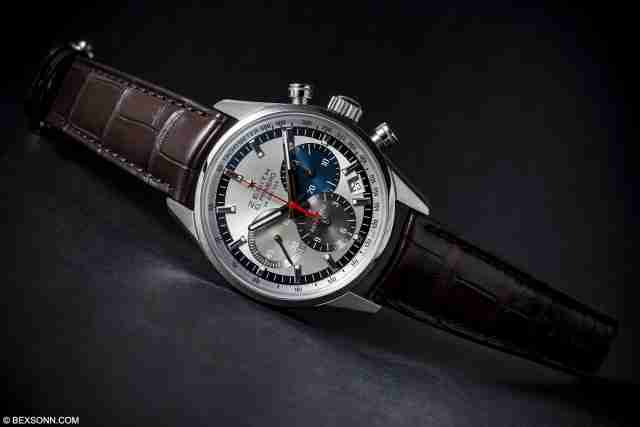 The El Primero 1969 pays homage to the A386 in a way that I believe more tributes should be done. While the El Primero, upon closer inspection, is missing some of the finer details of the original A386, such as: the beautiful italic inscription of “El Primero” on the dial or the telemeter scale that sits within the black chapter ring, or even the fact that the automatic inscription has moved from 12 to 6 o’clock and the dial features a Sunray finish instead of a matte white one. Does any of this matter?
The El Primero 1969 pays homage to the A386 in a way that I believe more tributes should be done. While the El Primero, upon closer inspection, is missing some of the finer details of the original A386, such as: the beautiful italic inscription of “El Primero” on the dial or the telemeter scale that sits within the black chapter ring, or even the fact that the automatic inscription has moved from 12 to 6 o’clock and the dial features a Sunray finish instead of a matte white one. Does any of this matter?
To the El Primero purist maybe but I think even they will be happy with what Zenith have done here. Not to mention that the original El Primero was produced in such small numbers that not only make it difficult to find one in good condition but also in working condition too. Then there is the matter of price when you do find a vintage El Primero – expect to pay anything between £7,000 and £10,000 for a good example.
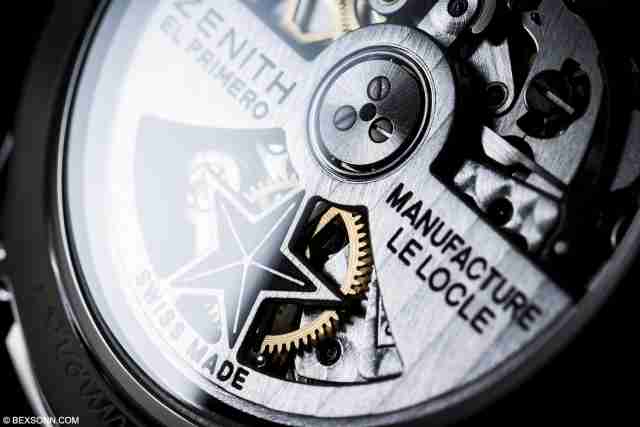 This is where I believe the El Primero shines; not only is it accessible but it’s also quite affordable too. It appeals to the watch enthusiast who is mindful of the A386 but doesn’t want to go through the rigmarole of having to search, find and then inspect to make sure everything is correct. It is no secret I love a good vintage timepiece and it is no different when it comes to the El Primero but the 1969 tribute is a watch that I could definitely see myself wearing on a more permanent basis, just look at what you get for your money.
This is where I believe the El Primero shines; not only is it accessible but it’s also quite affordable too. It appeals to the watch enthusiast who is mindful of the A386 but doesn’t want to go through the rigmarole of having to search, find and then inspect to make sure everything is correct. It is no secret I love a good vintage timepiece and it is no different when it comes to the El Primero but the 1969 tribute is a watch that I could definitely see myself wearing on a more permanent basis, just look at what you get for your money.
The El Primero, as mentioned, comes in 2 variations. On stainless steel bracelet or a brown Alligator strap that we managed to get our hands on. Priced at £6,100 and £5,700 respectively, in my opinion, is very good value when compared to other watch brands in-house column wheel chronographs.
For more information on the El Primero 1969, visit the official Zenith website.
